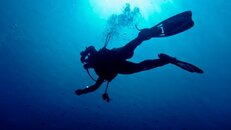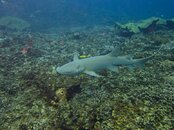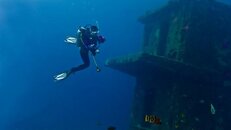As I suspected, I am in the minority here.
I don't think the question should be "how many dives" or "how many years of diving" because there are hundreds of reports in this forum where people have seen "experienced" divers doing stupid things, and some that never seem to learn.
On the other hand there are people who "get it" much quicker, or have a more balanced approach.
My attitude and priority when going into the water with a camera is;
1. Dive safe and learn something new, or practise at least one existing skill.
2. If the opportunity arises, grab some photos, but never let the photography get in the way.
I can certainly understand that if you let yourself get too focused (pun intended) on the photography, then thngs could get out of hand but my idea of scuba photography right now is simply to document and help remember my dives. I am not necessarily trying to create works of art.
I am not trying to blow my own trumpet here but let me give a typical dive scenario from my last vacation.
Just to understand, the "rig" I am using is very simple, a Canon S95 in a WP-DC38 case on an Inon arm base with a single S2000 strobe shooting wirelessly. This set has 200 grams negative buoyancy without any additional weights. I have this on an extendable lanyard that can be clipped short and close. Up to now I am shooting on Auto (Aperture priority) to keep my task loading with the camera to a minimum. Also, I only shoot in RAW so I don't need to get too anal about white balance and exposure. This allows more latitude to pull the image back to reasonable on the computer.
In addition to my wrist computer, I have my Citizen dive watch set with dive time alarm and max depth alarm, just in case I get carried away.
I enter the water, if from a boat I have my camera handed down to me, clip it to my BCD and
temporarily forget about it.
I descend with my buddy (my daughter in all cases so far) aiming for good control and achieve neutral buoyancy.
We swim to the reef or whatever is the key feature of the dive.
Only now do I grab my camera, extend the lanyard, switch on camera and strobe then swim.
My buddy lets me take the lead so that I am free to start or stop moving at will and know that she is going to be close by. Sometimes, my daughter will take the camera, then I become the trailing buddy.
After each stop (maybe 2 or 3 photos) the photographer confirms the presence of the trailing buddy.
If we are on a guided dive with several other divers, the trailing (non-camera) buddy will keep an eye on the pack and make sure we don't get left too far behind.
If a situation arises such as an unexpected current, bad visibility then the camera gets clipped on tight
and photography is abandoned.
For sure, I don't get 100% keepers from this type of photography but that is not the point. I am trying to improve step by step, having fun and most importantly keeping some beautiful memories.
Just to re-iterate, the images at
this link were all taken on my 6th to 10th dives with no external strobe.
Below are a few images from my 16th to 19th dives (in Guam) (all are reduced in size for bandwith)
(BTW, I know my daughter's alternate is dangling but the rental BCD's were not equipped with any retainers)
 Don't grab the camera until you are confident you are in control during the dive and don't try to be a National Geographic shooter on the first try - just get used to the new gear & enjoy yourself a bit. Watch yourself, talk to your buddy before the dive so you're both on the same page - be organized & prepared, then go for it and have fun!
Don't grab the camera until you are confident you are in control during the dive and don't try to be a National Geographic shooter on the first try - just get used to the new gear & enjoy yourself a bit. Watch yourself, talk to your buddy before the dive so you're both on the same page - be organized & prepared, then go for it and have fun!






